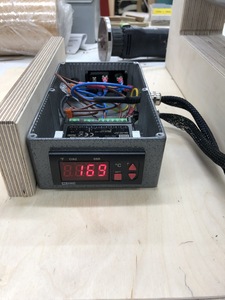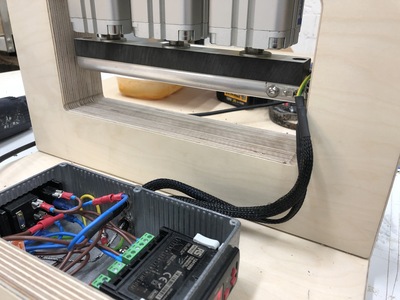I'm new to the full build game and have spent the last month or so kitting my little workshop/studio out with some basic tools, making jigs and prepping my timber for the build. Bought a silicone heating blanket from china somewhere. It arrived, looked ok and today I attempted doing my first side. I've bent sides before but with a steambox on a repair project and a separate botched build about 10 years ago. I had the sides thickness as between 2 - 2.2 mm on my depth gauge jig. I assumed the heat blanket controller would actually control the temp and looks identical to others I've seen on youtube; however I don't have an accurate thermometer and ended up using a meat thermometer (would not recommend!)... Anyhow the bending seemed to be going ok until I heard a cracking at around 90% of the centre clamping and what I assumed to be steam but turned out to be smoke. I turned the dial down low and carried on until I had the top and bottom clamped in my jig and off as soon as they were. After about 12 hours I went back and opened it up. It turns out that the heat was far too high and had charred the waist quite badly as well as there being a large crack between the bottom and top bout, on top of this the pink/orange rubbery stuff on the blanket on the caul side has puckered up and now has the consistency of 2 hour old chewing gum. My first question is this: can i still use the blanket or is that a costly right off? and secondly does it matter if my replacement sides are from a new set of mahogany of the same grade? I've already joined the back pretty seamlessly and started on the back strutting so don't want to chuck this. Any help would much appreciated!
Sorry to hear that ! Wish I'd seen this earlier as I could have answered you on the livestream today! Dang...
I'm thinking: The problem is that you do not have the complete kit - you are missing the temp sensor that plugs into the front of the control box (in my case).
The sensor is needed to tell the controller what temp the blanket has reached. It looks like a couple of thin wires joined at the end and insulated along most of the length. The bare end goes between the blanket and whatever you are heating.
ALSO!!
My controller also has a second safety feature in the form of a simple mechanical TIMER SWITCH.
This is very important!! I know several guitar makers who's workshops have gone up in flames - SERIOUSLY!!
That could very well have saved your sides...
Get the temp sensor and timer switch...
I know it is a bummer as the spending never seems to end - but safety is Number 1 !
Best advice:
I think the blanket is a write off - don't use it
Try to find some sides that match as good as possible...
and..ouch..
I feel your pain!!
To try and help others from experiencing this I will cover side bending using a blanket on the livestream - you were so close - just missing the sensor or it would have worked! Hopefully we can all learn from your mistake - thanks for sharing and sorry again for the delay in answering - I don't know how I missed it!!
Any chance you could send us some pics? You'll get massive KUDOS for sharing!!
Measure twice, cut once...
Yikes Hanniosman, scary shit!!!
When buying heater blankets I always use the same supplier, Holroyd Components, and specify them to run at 24V and with a watt density of 0.1W/cm2. This makes a blanket for guitar sides rated at about 110W. This provides plenty of power to cure the adhesive I use for laminated sides and brings the materials up to about 80°C for a period of 20 minutes. There is some leeway on the supply voltage so if I needed a higher temperature I could run these at 30V without a problem.
For heat bending solid sides I guess you will need a higher temperature but the idea of leaving high powered heater blankets running for 12 hours unattended scares the bejesus out of me, especially if you have no temperature controller. Do you know what temperature you avctually need to achieve?
There is a really neat little digital controller available from RS (stock number 124-1059, £57.59+VAT) which has a built in relay that can switch loads of up to 8A at 240V (1.9kW) and also has a control output so it could also be used to switch an external relay for either lower voltage supplies (for 24V pads for example) or for higher power 240V circuits but this shouldn't be necessary for guitar making purposes. Basically, you connect a suitable thermocouple (also available from RS, stock number 621-2209, £6.99+VAT, temp range up to 350°C) and the power will be cut to the heater pad once it has reached the set temperature and then cut back in again a few degrees below that. This is pretty much the set up I used on the heater bar on my pliage bending jig (see pics below) and you can see the thermocouple (with an eyelet) screwed to the right hand side of the heater bar. The T type thermocouple mentioned above is a 0.3mm diameter wire and so should be much easier to build into a bending jig.
You can buy a 24hour 240V timer switch from most supermarkets for about £7 and this can be used to shut the whole system down after a given period of time. Obviously, if you don't go into your workshop for 24hours the entire set up will switch on again but hopefully you're not going to forget about something like this!
If you speak to Holroyd they will be happy to advise on the most suitable power rating and watt density. My only tip would be to go for lower voltage if at all possible (24-48V) and specify eyelet termination rather than lead termination as this method of hooking up to the power circuit has proved to be more robust in my experience as the leads can break after a while with repeated flexing.
Better luck next time and just make sure that your fire extinguishers are in date and your smoke alarm is working!!
Darren
I’ve only used a bending iron as Covered in Marks course and using a template to work to rather than a mold.
It worked out ok (see around 5min mark if you can’t be bothered looking at the whole vid)
I have too many guitars...said no one in the world..ever!






